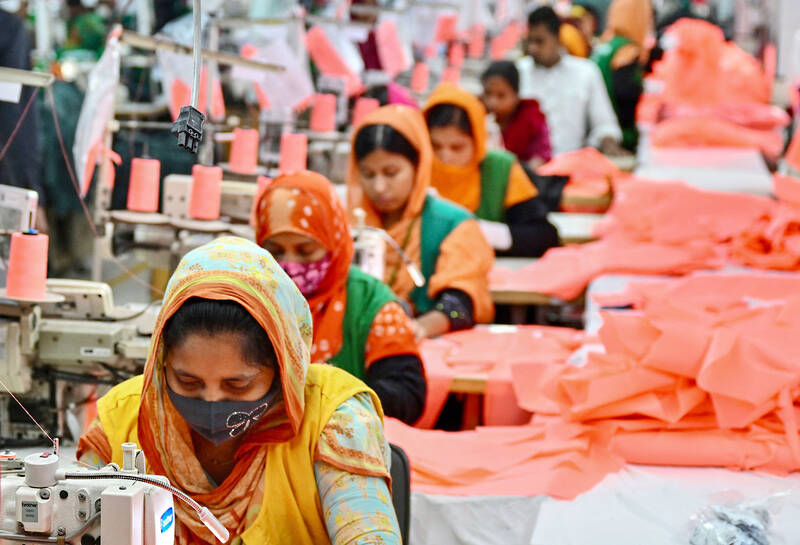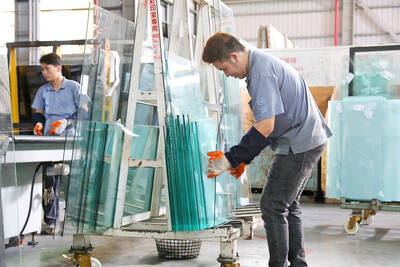In a vast Bangladeshi factory hall thrumming with sewing machines, garment workers churn out seemingly endless pairs of mountain hiking trousers for customers in Europe and North America.
Bangladesh’s key clothing manufacturing industry supplying global brands was crippled by a revolution that toppled the government last year, in which garment sector protesters played an important role.
While owners say business has bounced back, frustrated workers say hard-won concessions have done little to change their circumstances, and life remains as hard as ever.

Photo: AFP
“It is the same kind of exploitation,” garment worker Khatun, 24, said, asking that only her first name be used as speaking out would jeopardize her job.
Production in the world’s second-largest garment manufacturer was repeatedly stalled by the months-long violence, before protesters forced long-time autocrat former Bangladeshi prime minister Sheikh Hasina to flee in August last year.
An interim government, led by Nobel Peace Prize laureate Muhammad Yunus, took over.
However, protests continued in a string of garment factories for better conditions and more pay, with the Bangladesh Garment Manufacturers and Exporters Association (BGMEA) warning in October last year of US$400 million in losses.
Scores of factories closed and tens of thousands lost their jobs.
However, after a 5 percent wage hike was agreed in September, the industry rebounded.
“We are doing well,” said garment producer factory owner S.M. Khaled, who heads the Snowtex company, employing 22,000 workers.
The South Asian nation produces garments for global brands — ranging from France’s Carrefour, Canada’s Tire, Japan’s Uniqlo, Ireland’s Primark, Sweden’s H&M and Spain’s Zara.
The apparel industry accounts for about 80 percent of Bangladesh’s exports, earning US$36 billion last year, dropping little despite the unrest from the US$38 billion exported the previous year.
“I am working with at least 15 international brands, and our products will be available in 50 countries,” Khaled said. “Almost all garment factories are operating at full swing after waves of unrest. We are on the growth side.”
Despite challenges with a cooling of demand, Anwar Hossain, the government-appointed administrator of BGMEA, said the industry was returning to strength.
“The largest contributor to exports was the apparel sector,” Hossain said.
The garment industry recorded a 13 percent increase from July to December last year — the period after the ousting of Hasina — compared with the same period the year before, he said.
Workers tell a different story.
Khatun welcomed the wage rise, but said factory managers then hiked already onerous demands for “nearly unachievable production targets.”
Scraping by in the capital Dhaka’s gritty industrial suburb of Ashulia, she earns US$140 a month including overtime and benefits to support a family of four.
The wage increase of US$8.25 a month seems a miserly addition.
Opening her fist, she showed a 500 Bangladeshi taka (US$4) note, all she had left after paying rent and other expenses.
“We have good facilities inside the factory, like toilets, a canteen and water fountains,” she said. “But we don’t get even a 10-minute break while trying to meet the targets.”
Many factory owners were close to the former ruling party.
In the immediate days after Hasina was toppled, several factories were damaged in retaliatory attacks.
Some owners were arrested and accused of supporting Hasina, who is herself in exile in India skipping an arrest warrant for “massacres, killings and crimes against humanity.”
Most factories are now back in operation, but employees say some offer conditions far worse than before.
“We weren’t receiving salaries on time after the owner was arrested,” worker Rana said, also asking not to be identified.
“Now, they’ve offered me half my basic wage, around US$60 to US$70. I have a six-month-old child, a wife and elderly parents to support,” he added.
Hussain, who lost his job in the unrest, tells a common tale.
While he has since found work packing clothes, the new job means he “doesn’t benefit from the increment” deal, while living costs have risen.
“House rents have shot up with the news of the pay rise,” he said.
“Workers are struggling to maintain a minimum standard of living,” said Taslima Akhter, from the Bangladesh Garment Workers’ Solidarity group, a labor rights organization.
Factory bosses must push back against global purchasers wanting to maximize profits at the expense of a living wage, Akhter said.
“Garment [factory] owners need to take more responsibility and learn to negotiate better with international buyers,” she said. “This industry is not new, and problems are not impossible to solve.”
Despite the industry’s apparent fiscal success, former BGMEA director Abdullah Hil Raquib said it was on fragile ground.
“The stability in the garment sector we see now is only on the surface,” he said.

CAUTIOUS RECOVERY: While the manufacturing sector returned to growth amid the US-China trade truce, firms remain wary as uncertainty clouds the outlook, the CIER said The local manufacturing sector returned to expansion last month, as the official purchasing managers’ index (PMI) rose 2.1 points to 51.0, driven by a temporary easing in US-China trade tensions, the Chung-Hua Institution for Economic Research (CIER, 中華經濟研究院) said yesterday. The PMI gauges the health of the manufacturing industry, with readings above 50 indicating expansion and those below 50 signaling contraction. “Firms are not as pessimistic as they were in April, but they remain far from optimistic,” CIER president Lien Hsien-ming (連賢明) said at a news conference. The full impact of US tariff decisions is unlikely to become clear until later this month

With an approval rating of just two percent, Peruvian President Dina Boluarte might be the world’s most unpopular leader, according to pollsters. Protests greeted her rise to power 29 months ago, and have marked her entire term — joined by assorted scandals, investigations, controversies and a surge in gang violence. The 63-year-old is the target of a dozen probes, including for her alleged failure to declare gifts of luxury jewels and watches, a scandal inevitably dubbed “Rolexgate.” She is also under the microscope for a two-week undeclared absence for nose surgery — which she insists was medical, not cosmetic — and is

GROWING CONCERN: Some senior Trump administration officials opposed the UAE expansion over fears that another TSMC project could jeopardize its US investment Taiwan Semiconductor Manufacturing Co (TSMC, 台積電) is evaluating building an advanced production facility in the United Arab Emirates (UAE) and has discussed the possibility with officials in US President Donald Trump’s administration, people familiar with the matter said, in a potentially major bet on the Middle East that would only come to fruition with Washington’s approval. The company has had multiple meetings in the past few months with US Special Envoy to the Middle East Steve Witkoff and officials from MGX, an influential investment vehicle overseen by the UAE president’s brother, the people said. The conversations are a continuation of talks that

CHIP DUTIES: TSMC said it voiced its concerns to Washington about tariffs, telling the US commerce department that it wants ‘fair treatment’ to protect its competitiveness Taiwan Semiconductor Manufacturing Co (TSMC, 台積電) yesterday reiterated robust business prospects for this year as strong artificial intelligence (AI) chip demand from Nvidia Corp and other customers would absorb the impacts of US tariffs. “The impact of tariffs would be indirect, as the custom tax is the importers’ responsibility, not the exporters,” TSMC chairman and chief executive officer C.C. Wei (魏哲家) said at the chipmaker’s annual shareholders’ meeting in Hsinchu City. TSMC’s business could be affected if people become reluctant to buy electronics due to inflated prices, Wei said. In addition, the chipmaker has voiced its concern to the US Department of Commerce